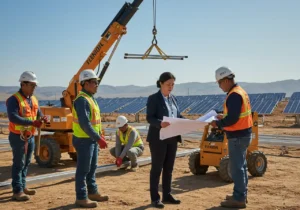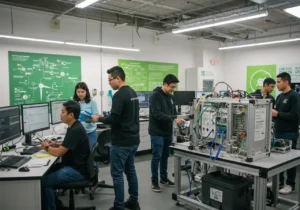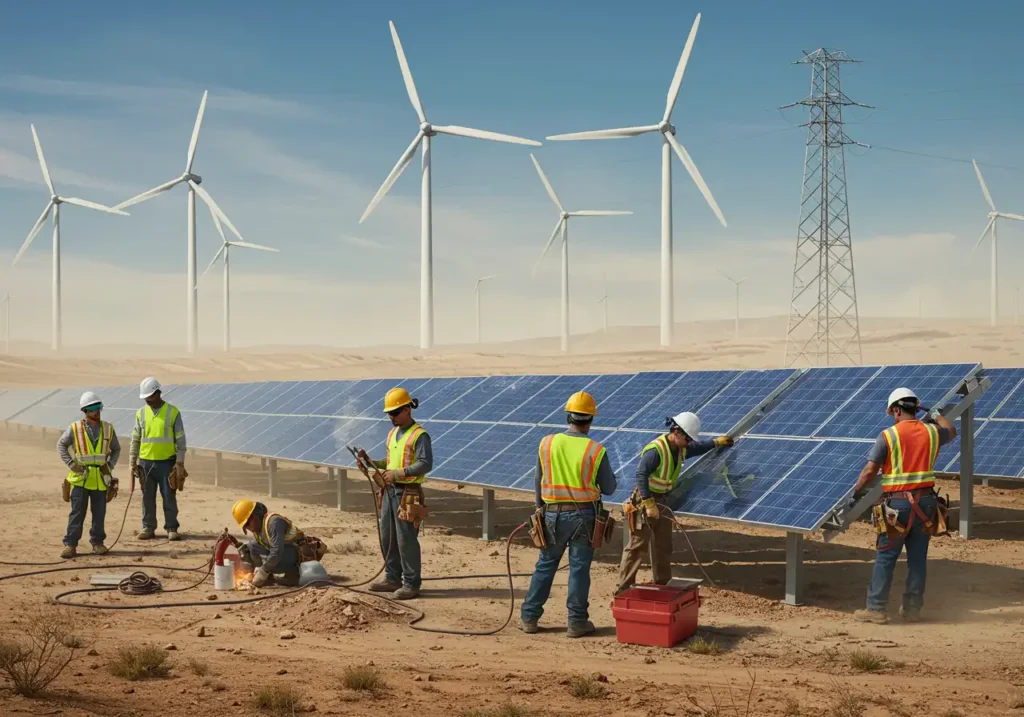California’s green economy is evolving rapidly, thanks to ambitious climate policies and significant investments in renewable energy. This sector is vital for the state’s economic growth and environmental future. By shifting to sustainable energy sources, California not only decreases its carbon footprint but also generates many job opportunities.
Key takeaway: Green policies are shaping the future workforce in California, creating an environment where renewable energy jobs flourish and contribute to a sustainable economy.
Legislative Foundations Driving the Green Economy
California’s green economy is supported by strong legislative action, with SB 350—also known as the Clean Energy and Pollution Reduction Act of 2015—serving as a key law. This law increased the state’s Renewables Portfolio Standard (RPS) to require that 50% of California’s electricity come from renewable sources by 2030. The statute set a clear mandate for utilities and energy providers, leading to significant investment in solar, wind, geothermal, and other renewables.
Key impacts of SB 350 and related climate policies in California:
- Mandatory Renewable Expansion: Utilities must build or procure renewable power plants and modernize transmission infrastructure to meet RPS targets. This has led to large-scale construction projects across the state.
- Acceleration of Infrastructure: Legislative certainty has provided stable ground for private and public investments in clean energy infrastructure, reducing risk for developers and making long-term planning possible.
- Job Creation: The construction of new renewable power plants and grid upgrades has produced significant employment opportunities. Building trades unions have played a central role—workers secure family-supporting wages and benefits as they construct solar farms, wind installations, battery storage sites, and transmission lines. As highlighted in this report on the link between good jobs and a low-carbon future, these jobs are not just vital for individual families but also crucial for the broader transition to a sustainable economy.
“The mandate embedded in SB 350 is not just about cleaner energy—it’s about building a new workforce for a sustainable economy.”
Legislative actions like SB 350 continue to drive California’s transition, ensuring that policy commitments result in real projects and jobs on the ground.
Growth of Clean Energy Jobs in California
 Clean energy jobs in California have surged as a direct response to the state’s ambitious renewable energy goals. Between 2002 and 2015, the renewable energy sector experienced robust expansion, adding tens of thousands of job-years as new solar, wind, and geothermal projects came online. The demand for skilled labor spanned a wide spectrum of roles:
Clean energy jobs in California have surged as a direct response to the state’s ambitious renewable energy goals. Between 2002 and 2015, the renewable energy sector experienced robust expansion, adding tens of thousands of job-years as new solar, wind, and geothermal projects came online. The demand for skilled labor spanned a wide spectrum of roles:
- Blue-collar positions: Electricians, ironworkers, and operating engineers formed the backbone of utility-scale solar and wind installations. These jobs offered hands-on construction, equipment operation, and maintenance responsibilities.
- White-collar opportunities: Project managers, engineers, environmental analysts, and compliance specialists played critical roles in planning, permitting, and overseeing complex infrastructure projects.
Building trades unions have played a central role in shaping workforce standards across these projects. Through collective bargaining agreements and apprenticeship programs, unions ensure that clean energy jobs in California deliver family-supporting wages and comprehensive benefits packages. Prevailing wage requirements attached to public investment mean that workers benefit from stable employment and economic security.
The geographic reach of these opportunities often extends into regions with historically high unemployment rates or lower incomes. Renewable project development translates into local hiring for both skilled tradespeople and professionals—supporting families while driving regional economic growth. Clean energy careers now offer upward mobility that rivals traditional fossil fuel sectors without sacrificing wage quality or job stability.
Governor Newsom’s Climate Plan and Workforce Implications
Governor Gavin Newsom’s climate plan aims to achieve carbon neutrality by 2045, with ambitious targets for reducing greenhouse gas emissions and cutting oil usage. The plan outlines an 85% reduction in greenhouse gas emissions and a 94% decrease in oil consumption, setting the stage for a transformative shift in California’s energy landscape.
Key goals of the plan include:
- Deploying six million heat pumps
- Constructing millions of climate-ready homes by 2030-2035
- Expanding renewable energy infrastructure
The impact on the workforce is substantial, with projections indicating the creation of approximately 4 million new jobs. These jobs span various sectors, from construction and manufacturing to tech development and maintenance.
Examples of employment opportunities tied to this plan include:
- Renewable energy engineers designing next-generation solar panels and wind turbines
- Construction workers who are building new sustainable housing and retrofitting existing buildings
- Technicians and maintenance staff ensure the efficient operation of renewable energy systems
The focus on green technologies not only supports environmental goals but also promises significant economic benefits by generating high-quality jobs that offer fair wages and long-term career prospects. The future of work in California’s green economy hinges on the successful implementation of these ambitious climate initiatives, positioning the state as a leader in both environmental sustainability and economic innovation.
Innovation and Technology in Decarbonization Sectors
 Emerging technologies are transforming California’s industries, with a significant impact on the workforce. In the transportation sector, innovations such as electric vehicles (EVs) and autonomous driving systems are creating new job opportunities in engineering, software development, and manufacturing. Companies like Tesla and Rivian are leading this change, requiring skilled workers to design, build, and maintain these advanced vehicles.
Emerging technologies are transforming California’s industries, with a significant impact on the workforce. In the transportation sector, innovations such as electric vehicles (EVs) and autonomous driving systems are creating new job opportunities in engineering, software development, and manufacturing. Companies like Tesla and Rivian are leading this change, requiring skilled workers to design, build, and maintain these advanced vehicles.
In manufacturing, improvements in energy efficiency and robotics are changing production processes. The use of smart grid technologies improves energy management, lowering emissions while increasing operational efficiencies. This evolution requires a workforce skilled in both traditional mechanical abilities and advanced digital skills.
The growth of clean fuel production is another important area driving job growth. Innovations in hydrogen fuel cells and biofuels are not only reducing carbon emissions but also creating jobs at different stages of the supply chain—from research and development to production and distribution.
Job Opportunities in Clean Transportation
The shift towards clean transportation is generating various employment opportunities, including:
- Roles in electric vehicle (EV) manufacturing
- Positions related to charging infrastructure installation
- Jobs focused on the maintenance and servicing of EVs
Employment Prospects in Clean Fuels
The advancements in clean fuels such as hydrogen and biofuels are also contributing to job creation. Some key areas where employment opportunities are emerging include:
- Hydrogen production facilities
- Biofuel plants
- Supporting logistics networks involved in the transportation and distribution of clean fuels
These developments highlight the dynamic nature of California’s green economy. It not only positions the state as a leader in sustainable innovation but also promotes diverse employment opportunities across various sectors.
Equitable Economic Development in the Green Transition
Prioritizing equitable green jobs is central to California’s strategy for a just transition. Investments are being directed toward disinvested communities—areas historically left out of economic growth—to ensure that the benefits of clean energy extend across the state. Programs such as targeted workforce training, local hiring requirements, and community benefit agreements help channel job opportunities where they’re needed most.
Collaboration stands out as a key driver. Environmental groups partner with labor organizations in California, businesses, and academic institutions to align climate initiatives with inclusive hiring practices. This approach supports pathways into union trades for underrepresented populations and leverages apprenticeship programs that guarantee fair wages, benefits, and long-term career prospects.
- Regional planning efforts prioritize projects in low-income or high-unemployment zones.
- Academic partnerships focus on upskilling residents for emerging sectors like clean fuels and advanced building technologies.
Sustained partnerships enable California’s green economy to tackle both environmental goals and economic disparities at scale.
Comparing California’s Green Economy Transition to Historic Initiatives
The scale of California’s green economy transition draws frequent comparisons with the New Deal. The New Deal reshaped America through sweeping infrastructure investment jobs, and workforce mobilization. Today, the future of work in California’s green economy is defined by a similar, transformative economic opportunity—this time driven by climate policy and clean energy.
-
Massive Infrastructure Projects
From transmission lines crisscrossing the Central Valley to solar and wind farms rising in the desert, large-scale development is unlocking thousands of new jobs. These projects echo the ambitious efforts of the 1930s, not just in size but in their promise to transform communities and support family-sustaining employment.
-
Multi-Sector Impact
The reach of these initiatives extends across construction, engineering, advanced manufacturing, and ecosystem restoration. This broad approach ensures that infrastructure investment jobs are available to a wide range of skill sets and educational backgrounds.
By framing the green transition as more than just an environmental necessity—but as a generational economic engine—California positions itself at the forefront of sustainable job creation.
Conclusion
California’s green economy delivers a rare combination:
- Environmental sustainability: Large-scale reductions in emissions, cleaner air, and restored landscapes protect public health and natural resources for generations.
- Economic opportunity: Construction of renewable infrastructure, expansion of clean industries, and innovation in technology drive new jobs and business growth.
The outlook for the future workforce in California is shaped by policies that support both climate action and sustainable economic growth. Workers benefit from family-supporting wages, while communities see new investments and revitalization—especially in regions historically left behind. Innovation continues to redefine what’s possible in sectors from clean transportation to advanced manufacturing.
The Future of Work in California’s Green Economy is marked by resilience, adaptability, and inclusion—a model for states nationwide seeking a sustainable path forward.
With continued commitment, the green job outlook remains strong, fueling a dynamic workforce prepared to meet tomorrow’s challenges and opportunities.

